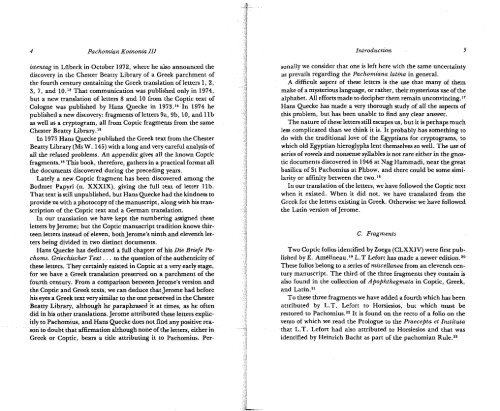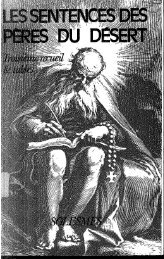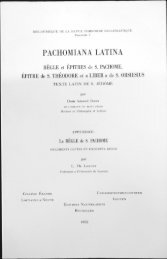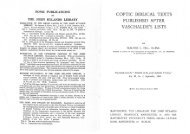pachorn~an ko~nonla - Alin Suciu
pachorn~an ko~nonla - Alin Suciu
pachorn~an ko~nonla - Alin Suciu
You also want an ePaper? Increase the reach of your titles
YUMPU automatically turns print PDFs into web optimized ePapers that Google loves.
4 Pachomian Koinonia 111 Introductzon 5<br />
wtentag in Liibeck in October 1972, where he also announced the<br />
discovery in the Chester Beatty Library of a Greek parchment of<br />
the fourth century containing the Greek translation of letters 1, 2,<br />
3, 7, and 10.lS That communication was published only in 1974,<br />
but a new translation of letters 8 and 10 from the Coptic text of<br />
Cologne was published by Hans Quecke in 1973.14 In 1974 he<br />
published a new discovery: fragments of letters 9a, 9b, 10, and llb<br />
as well as a cryptogram, all from Coptic fragments from the same<br />
Chester Beatty Library.15<br />
In 1975 Hans Quecke published the Greek text from the Chester<br />
Beatty Library (Ms W. 145) with a long and very careful analysis of<br />
all the related problems. An appendix gives all the known Coptic<br />
fragments.'@ This book, therefore, gathers in a practical format all<br />
the documents discovered during the preceding years.<br />
Lately a new Coptic fragment has been discovered among the<br />
Bodmer Papyri (n. XXXIX), giving the full text of letter llb.<br />
That text is still unpublished, but Hans Quecke had the kindness to<br />
provide us with a photocopy of themanuscript, along with his tran-<br />
scription of the Coptic text and a German translation.<br />
In our translation we have kept the numbering assigned these<br />
letters by Jerome; but the Coptic manuscript tradition knows thir-<br />
teen letters instead of eleven, both Jerome's ninth and eleventh let-<br />
ters being divided in two distinct documents.<br />
Hans Quecke has dedicated a full chapter of his Die Briefe Pa-<br />
choms. Gnechzscher Text. . to the questionof the authenticity of<br />
these letters. They certainly existed in Coptic at a very early stage,<br />
for we have a Greek translation preserved on a parchment of the<br />
fourth century. From a comparison between Jerome's version and<br />
the Coptic and Greek texts, we can deduce that Jerome had before<br />
his eyes a Greek text very similar to the one preserved in the Chester<br />
Beatty Library, although he paraphrased it at times, as he often<br />
did in his other translations. Jerome attributed these letters explic-<br />
itly to Pachomius, and Hans Quecke does not find any positive rea-<br />
son to doubt that affirmation although none of the letters, either in<br />
Greek or Coptic, bears a title attributing it to Pachomius. Per-<br />
sonally we consider that one is left here with the same uncertainty<br />
as prevails regarding the Pachomiana latzna in general.<br />
A difficnlt aspect of these letten is the use that many of them<br />
make of a mysterious language, or rather, their mysterious use of the<br />
alphabet. All efforts made to decipher them remain unconvincing. l7<br />
Hans Quecke has made a very thorough study of all the aspects of<br />
this problem, but has been unable to find any clear answer.<br />
The nature of these letters still escapes us, but it is perhapsmuch<br />
less complicated than we think it is. It probably has something to<br />
do with the traditional love of the Egyptians for cryptograms, to<br />
which old Egyptian hieroglyphs lent themselves so well. The use of<br />
series of vowels and nonsense syllables is not rare either in the gnos-<br />
tic documents discovered in 1946 at Nag Hammadi, near the great<br />
basilica of St Pachomius at Phbow, and there could be some simi-<br />
larity or affinity between the two.LB<br />
In our translation of the letters, we have followed the Coptic text<br />
when it existed. When it did not, we have translated from the<br />
Greek for the letters existing in Greek. Otherwise we have followed<br />
the Latin version of Jerome.<br />
C. Fragments<br />
Two Coptic folios identified by Zoega (CLXXIV) were first published<br />
by E. Amelinea~.'~ L.T Lefort has made a newer edition.Po<br />
These folios belong to a series of miscellanea from an eleventh century<br />
manuscript. The third of the three fragments they contain is<br />
also found in the collection of Apophthegmata in Coptic, Greek,<br />
and Latin.2'<br />
To these three fragments we have added a fourth which has been<br />
attributed by L.T. Lefort to Horsiesios, but which must be<br />
restored to Pachomius.PP It is found on the recto of a folio on the<br />
verso of which we read the Prologue to the P~aecepta et Institutu<br />
that L.T. Lefort had also attributed to Horsiesios and that was<br />
identified by Heinrich Bacht as part of the pachomian Rule.P1







